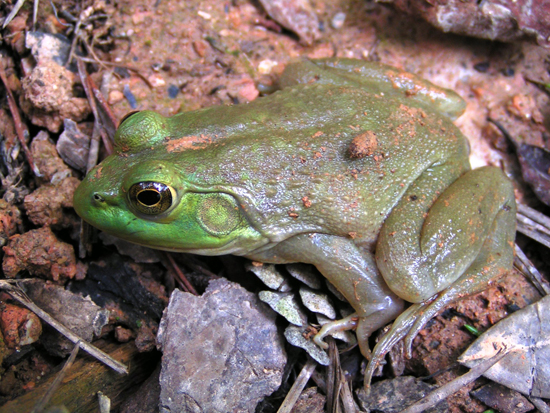Frogs Crossing the Road in the Rain
A frog fan, Brian, emailed about the frogs in his area crossing the road when it rains, and I asked a few experts to advise him. We all agreed to share this content so you can know what to do in your own area.
Brian asks:
To reiterate our conversation, there is an ecosystem in and around the Salt Pond community in Bethany Beach DE, which subsequently is intertwined by a few roads. There is one particular stretch of about two blocks where, like clockwork, when it rains the frogs cover the street. It seems to be two species doing this; the bull frogs and little peepers. I did a rough estimation of about 125 of these frogs are being killed by car traffic every time it rains. That’s roughly 4000 per summer season. What is it about the rain that draws these frogs to the pavement? And what practical solution can be done to lessen the slaughter?
Best regard, Brian H.
Two responses from the experts:
Hi Susan and Brian,
Happy for others to chirp in as well, but the frogs are not so much attracted to the pavement, but the rains signaling the fact that its time to breed! So when this happens the frogs migrate from where they live their everyday lives to a suitable breeding site, which hopefully still exists. I’ve seen cases where the traditional ponds have been turned into carparks or shopping malls and all the frogs turn up and say “WTF?” And inevitably die. There is another explanation and that depends upon the size of the frogs – if they are adults then the above explanation is probably true, however if they are metamorps or juveniles then its quite likely this is a mass migration AWAY from the breeding site of newly developed froglets to find a good place to live and the only way they can avoid drying out on the hostile pavements is to travel when it rains.
OK – what can be done to save them?
People try many things, during rainy days you can get volunteers to help the frogs across the roads, you can put signs up to warn motorists and tell them to be careful, you can close the roads – all these have differing successes depending on manpower, but the best solution is to advocate for some frogs tunnels and drift fences to be installed. Essentially you erect a barrier, which for these species would need to be carefully constructed as peepers can climb very well and bullfrogs can jump very well, and these barriers prevent the frogs from crossing the road and direct them to an underpass where they can cross the road safely (obviously the same needs to happen on the other side so that they don’t get squashed coming back). Having said all this, both the species mentioned are fairly common species and are not under threat (although it would be good to get their ID professionally confirmed) and are not in decline – at the moment, so it would be difficult to motivate city councils or governments to take action for a fairly common species. But its great that Brian wants to do something an it would be great if Kerry Kriger (Save the Frogs) or I can help.
All the best
Phil Bishop
Associate Professor
Chief Scientist
Amphibian Survival Alliance

Brian,
Susan with Frogs Are Green forwarded your e-mail to me. Roadways are a huge problem for herpetofauna as you’ve found out. The frogs are mostly likely coming out on the roads during rainy nights to move to breeding grounds or in search of food. Frogs love rainy nights and move around a lot during them. Some possible solutions to help save the frogs are to petition the city and or your local Fish and Wildlife/Dept of Natural Resources office to install frog crossing signs and get the speed limit lowered and/or to install fencing that diverts the frogs to an under road crossing (if one is nearby). If this is a little used road you might asked that it be closed during certain seasons like the famous snake road in the Pine Hills in Southern Illinois that is closed twice a year to allow rattlesnakes to migrate. Another possibility is to start a citizen group that devotes time to cruising the roads on rainy nights saving the frogs. I’ve heard of a few areas in the US where people do this.
Thanks for being concerned about the frogs.
Cheers!
— Sara Viernum, The Wandering Herpetologist




